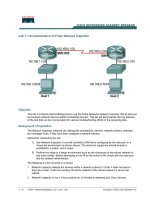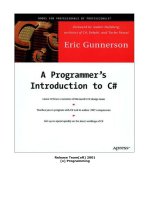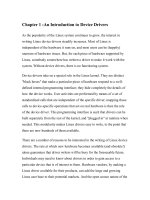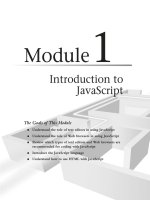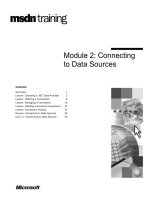Module 2- Lesson 1&2 – Introduction to EIGRP pptx
Bạn đang xem bản rút gọn của tài liệu. Xem và tải ngay bản đầy đủ của tài liệu tại đây (1.17 MB, 45 trang )
© 2008 Cisco Systems, Inc. All rights reserved. Cisco ConfidentialBSCI
1
Configuring EIGRP
BSCI Module 2- Lesson 1&2 – Introduction to EIGRP
© 2008 Cisco Systems, Inc. All rights reserved.BSCI
2
CCNP – BSCI Bachkhoa Networking Academy
Học viện mạng Bách Khoa - www.bkacad.com
Objectives
This module will cover topics which allow students to
meet the following objectives:
–Describe the key capabilities that distinguish EIGRP from
other routing protocols
–Identify the four key technologies employed by EIGRP
–Describe how EIGRP operates
–Describe the five components of the metric used by EIGRP
–Calculate the EIGRP metric for a range of pathways between
routers
–Explain how IGRP routes are integrated into EIGRP routes
and vice-versa
© 2008 Cisco Systems, Inc. All rights reserved.BSCI
3
CCNP – BSCI Bachkhoa Networking Academy
Học viện mạng Bach Khoa - Website: www.bkacad.com
3
The Evolution of Dynamic Routing Protocols
© 2008 Cisco Systems, Inc. All rights reserved.BSCI
4
CCNP – BSCI Bachkhoa Networking Academy
Học viện mạng Bach Khoa - Website: www.bkacad.com
4
Dynamic Routing Protocols Classification
© 2008 Cisco Systems, Inc. All rights reserved.BSCI
5
CCNP – BSCI Bachkhoa Networking Academy
Học viện mạng Bach Khoa - Website: www.bkacad.com
5
IGP and EGP
An autonomous system (AS) - otherwise known as a routing
domain - is a collection of routers under a common administration.
Two types of routing protocols are: interior and exterior routing
protocols.
–Interior Gateway Protocols (IGP) are used for intra-autonomous
system routing - routing inside an autonomous system.
–Exterior Gateway Protocols (EGP) are used for inter-
autonomous system routing - routing between autonomous
systems.
© 2008 Cisco Systems, Inc. All rights reserved.BSCI
6
CCNP – BSCI Bachkhoa Networking Academy
Học viện mạng Bach Khoa - Website: www.bkacad.com
6
Distance Vector and Link State
Interior Gateway Protocols (IGPs) can be classified as two types:
–Distance vector routing protocols
–Link-state routing protocols
Distance Vector Routing Protocol Operation
Distance vector means that routes are advertised as vectors of
distance and direction.
–Distance is defined in terms of a metric such as hop count .
–Direction is simply the next-hop router or exit interface.
–Algorithm is Bellman-Ford.
© 2008 Cisco Systems, Inc. All rights reserved.BSCI
7
CCNP – BSCI Bachkhoa Networking Academy
Học viện mạng Bach Khoa - Website: www.bkacad.com
7
Distance Vector and Link State
Distance Vector Routing Protocol Features:
–The network is simple and flat and does not require a special
hierarchical design.
–The administrators do not have enough knowledge to configure
and troubleshoot link-state protocols.
–Specific types of networks, such as hub-and-spoke networks,
are being implemented.
–Worst-case convergence times in a network are not a concern.
© 2008 Cisco Systems, Inc. All rights reserved.BSCI
8
CCNP – BSCI Bachkhoa Networking Academy
Học viện mạng Bach Khoa - Website: www.bkacad.com
8
Distance Vector and Link State
Link-state Protocol Operation
A link-state router uses the link-state information to create a topology
map and to select the best path to all destination networks in the
topology.
Link-state protocols Features:
–The network design is hierarchical, usually occurring in large
networks.
–The administrators have a good knowledge of the implemented link-
state routing protocol.
–Fast convergence of the network is crucial.
© 2008 Cisco Systems, Inc. All rights reserved.BSCI
9
CCNP – BSCI Bachkhoa Networking Academy
Học viện mạng Bách Khoa - www.bkacad.com
Purpose of this Lesson
Coverage of topics new to the “EIGRP” module of BSCI.
What’s new in this module?
–EIGRP metric calculations for pathway ranges between
routers.
© 2008 Cisco Systems, Inc. All rights reserved.BSCI
10
CCNP – BSCI Bachkhoa Networking Academy
Học viện mạng Bách Khoa - www.bkacad.com
EIGRP Features
There are several key differences with EIGRP from other routing
protocols which are explored in this module.
Hybrid Cisco Routing Protocol
Fast convergecen
VLSM & Discontigous: Classless Routing Protocol
Partial Updates
Multiple L3 protocol: IP, IPX, Apple Talk
Composite Metric
© 2008 Cisco Systems, Inc. All rights reserved.BSCI
11
CCNP – BSCI Bachkhoa Networking Academy
Học viện mạng Bách Khoa - www.bkacad.com
EIGRP Features
© 2008 Cisco Systems, Inc. All rights reserved.BSCI
12
CCNP – BSCI Bachkhoa Networking Academy
Học viện mạng Bách Khoa - www.bkacad.com
EIGRP Key Technologies
Protocol-dependent modules (PDMs)
Reliable Transport Protocol (RTP)
Neighbor discover/recovery
DUAL finite-state machine
© 2008 Cisco Systems, Inc. All rights reserved.BSCI
13
CCNP – BSCI Bachkhoa Networking Academy
Học viện mạng Bách Khoa - www.bkacad.com
Protocol-dependent Modules
The IP-EIGRP module
–Sending and receiving EIGRP packets that are encapsulated
in IP.
–Parsing EIGRP packets and informing DUAL of the new
information that has been received.
–Asks DUAL to make routing decisions. These results are then
stored in the IP routing table.
–Redistributing routes learned by other IP routing protocols.
Each protocol has its
own EIGRP module
and operates
independently from
any of the others that
may be running.
© 2008 Cisco Systems, Inc. All rights reserved.BSCI
14
CCNP – BSCI Bachkhoa Networking Academy
Học viện mạng Bách Khoa - www.bkacad.com
EIGRP is protocol-independent; that is, it doesn’t rely on TCP/IP to
exchange routing information the way RIP, IGRP, and OSPF do.
To stay independent of IP, EIGRP uses the transport-layer protocol to
guarantee delivery of routing information: RTP.
RTP supports reliable and unreliable delivery
RTP supports unicasting and multicasting
Initial delivery of EIGRP messages are done using multicast packets, that is
data is sent to all neighbors on a segment, and every neighbor is expected to
acknowledge it with a unicast Hello packet.
After adjacency has been formed and added to neighbor table, routers
exchange routing information which is stored in the topology table. (later)
RTP is used for EIGRP queries, updates and replies
RTP is not used for EIGRP Hello’s and Ack’s
Reliable Transport Protocol
© 2008 Cisco Systems, Inc. All rights reserved.BSCI
15
CCNP – BSCI Bachkhoa Networking Academy
Học viện mạng Bách Khoa - www.bkacad.com
Initial Route Discovery
© 2008 Cisco Systems, Inc. All rights reserved.BSCI
16
CCNP – BSCI Bachkhoa Networking Academy
Học viện mạng Bách Khoa - www.bkacad.com
Activity
Identify the four key steps of EIGRP operation.
© 2008 Cisco Systems, Inc. All rights reserved.BSCI
17
CCNP – BSCI Bachkhoa Networking Academy
Học viện mạng Bách Khoa - www.bkacad.com
Activity Answer
© 2008 Cisco Systems, Inc. All rights reserved.BSCI
18
CCNP – BSCI Bachkhoa Networking Academy
Học viện mạng Bách Khoa - www.bkacad.com
DUAL selects alternate routes quickly by using the information in the EIGRP
tables.
If a link goes down, DUAL looks for a feasible successor in its neighbor and
topology tables.
A successor is a neighboring router that is currently being used for packet
forwarding, provides the least-cost route to the destination, and is not part of a
routing loop.
Feasible successors provide the next lowest-cost path without introducing
routing loops.
–Feasible successor routes can be used in case the existing route fails;
packets to the destination network are immediately forwarded to the feasible
successor, which at that point, is promoted to the status of successor.
Selects a best loop-free path to a destination, the next hop being known as the
successor.
All other routers to the same destination, that also meet the feasible condition,
meaning they are also loop-free (later), become feasible successors, or back-
up routes.
debug eigrp fsm
DUAL FSM – Explained in a moment…
© 2008 Cisco Systems, Inc. All rights reserved.BSCI
19
CCNP – BSCI Bachkhoa Networking Academy
Học viện mạng Bách Khoa - www.bkacad.com
The Diffusing Update Algorithm (DUAL)
How does EIGRP determine
which routes are loop-free?
B with a cost of 10
Each of A’s neighbors is
reporting reachability to E:
C with a cost of 10
D with a cost of 30
These three costs are
called the reported
distance (RD); the
distance each neighbor is
reporting to a given
destination
© 2008 Cisco Systems, Inc. All rights reserved.BSCI
20
CCNP – BSCI Bachkhoa Networking Academy
Học viện mạng Bách Khoa - www.bkacad.com
The Diffusing Update Algorithm (DUAL)
At A, the total cost to reach
E is:
The best of these three
paths is the path through
B, with a cost of 20
–20 through B
–25 through C
–45 through D
This is the feasible distance
(FD)
© 2008 Cisco Systems, Inc. All rights reserved.BSCI
21
CCNP – BSCI Bachkhoa Networking Academy
Học viện mạng Bách Khoa - www.bkacad.com
The Diffusing Update Algorithm (DUAL)
A uses the FD and the RD
to determine which paths
are loop-free
The best path (FD) is used
as a benchmark; all paths
with RDs lower than the FD
cannot contain loops
The algorithm may mark
some loop-free paths as
loops
However, it is guaranteed
never to mark a looped path
as loop-free
© 2008 Cisco Systems, Inc. All rights reserved.BSCI
22
CCNP – BSCI Bachkhoa Networking Academy
Học viện mạng Bách Khoa - www.bkacad.com
The Diffusing Update Algorithm (DUAL)
At A:
–The path through B is
the best path (FD), at 20
C can reach E with a cost
of 10; 10 (RD) is less than
20 (FD), so this path is
loop-free.
D can reach E with a
cost of 30; 30 (RD) is
not less than 20 (FD),
so EIGRP assumes
this path is a loop.
© 2008 Cisco Systems, Inc. All rights reserved.BSCI
23
CCNP – BSCI Bachkhoa Networking Academy
Học viện mạng Bách Khoa - www.bkacad.com
Example from the curriculum…
1 2
3
4
© 2008 Cisco Systems, Inc. All rights reserved.BSCI
24
CCNP – BSCI Bachkhoa Networking Academy
Học viện mạng Bách Khoa - www.bkacad.com
Example from the curriculum…
5 6
7
© 2008 Cisco Systems, Inc. All rights reserved.BSCI
25
CCNP – BSCI Bachkhoa Networking Academy
Học viện mạng Bách Khoa - www.bkacad.com
EIGRP Tables

